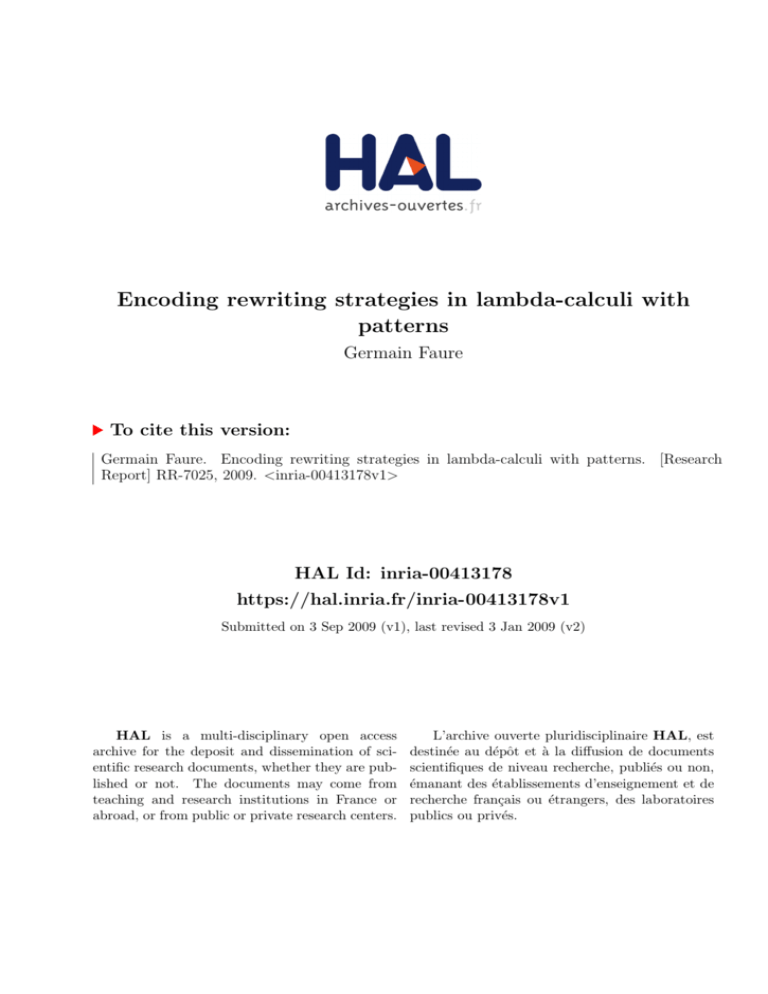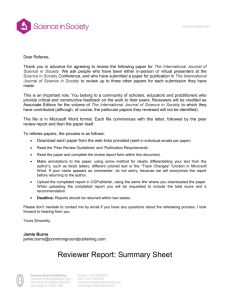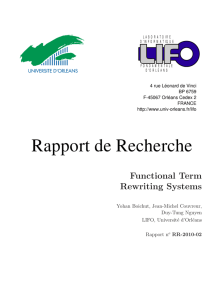Encoding rewriting strategies in lambda-calculi with patterns
advertisement

Encoding rewriting strategies in lambda-calculi with patterns Germain Faure To cite this version: Germain Faure. Encoding rewriting strategies in lambda-calculi with patterns. [Research Report] RR-7025, 2009. <inria-00413178v1> HAL Id: inria-00413178 https://hal.inria.fr/inria-00413178v1 Submitted on 3 Sep 2009 (v1), last revised 3 Jan 2009 (v2) HAL is a multi-disciplinary open access archive for the deposit and dissemination of scientific research documents, whether they are published or not. The documents may come from teaching and research institutions in France or abroad, or from public or private research centers. L’archive ouverte pluridisciplinaire HAL, est destinée au dépôt et à la diffusion de documents scientifiques de niveau recherche, publiés ou non, émanant des établissements d’enseignement et de recherche français ou étrangers, des laboratoires publics ou privés. ENCODING REWRITING STRATEGIES IN λ-CALCULI WITH PATTERNS by Germain Faure Abstract. — We propose a patch to the pure pattern calculus: we claim that this is strictly more powerful to define the application of the match fail as the pure λ-term defining the boolean false instead of the identity function as it is done in the original version of the pure pattern calculus [JK09]. We show that using non algebraic patterns we are able to encode in a natural way any rewriting strategies as well as the branching construct | used in functional programming languages. We close the open question (raised in [Cir00, CK01]) whether rewriting strategies can be directly encoded in λ-calculi with patterns. 1. Preliminaries We first recall some classical encoding of pairs, boolean etc. in the pure λ-calculus (see for example [Bar84]) ht, ui π1 t π2 t = λx. x t u = t (λxy. x) = t (λxy. y) true false if t then u else v = λxy. x = λxy. y = tuv let x = t in u = (λx. u) t fix = (λx. λf. f (x x f )) (λx. λf. f (x x f )) If C[] is a context then we will write f un = fix(C[f un]) for the definition of a recursive function called f un and defined by fix (λs. C[s]). 2. Yet a more general framework We consider the general framework given in Section 2 of [JK09] and use the same notations. We first begin by a remark. The application of a match µ to a term can be defined in a more general way as follows: If µ is a substitution, then the application of the match to a term is obtained by applying the substitution to variables of the term as explained in [JK09]. If µ is fail, we define fail t = u where u is an arbitrary term [the calculus is parametrized by this term u]. Theorem 2.1 (Confluence). — The pure pattern calculus, as defined in Section 3 of [JK09] but with the above application of a match, is confluent when u is a pure λ-term in normal form. Proof. — Exactly the same as the one of the original paper. Note that the case fail t = [x] x b→x is now subsumed. 3. Encoding strategies In this section, we give a semantics to rewriting strategies as they are used in rewriting-based languages such as Tom [BBK+ 07] or Stratego [Vis01]. We refer for example to [Rei06, BMR08] for their presentation. In the original paper on the rewriting calculus, rewriting strategies were encoded in an ad-hoc extension, using what they called the first operator. But the question whether rewriting strategies can be directly encoded in λ-calculi with patterns were remained open. 3.1. Informal presentation of the encoding. — To encode strategies, we need to test failure and success, in particular to encode the choice operator. In the following, a strategy is going to be encoded by a function returning a pair made of first a boolean whose value depends on the success or failure of the strategy application and secondly, in case of success, the second term of the pair represent the result of the strategy application. We then use the following encoding(1) first(t1 , t2 ) = λx. let a = t1 x in if π1 a then a else t2 x 3.2. Definition and properties of the encoding. — We now suppose given an instance of the pure pattern calculus where the application of the match fail is given by: fail t = false where false is defined in Section 1. We want that the function φ giving the encoding of strategies in the pure pattern calculus (and defined below) satisfies the following theorem Theorem 3.1. — For any strategy s, for any terms t and u: if t →∗s u (t rewrites to u under the strategy s) then if u a failure hfalse, i ∗ φ(s) t → htrue, ui otherwise where denotes a term depending on s, t, u and of which we don’t care the value. Definition 3.2. — The function φ is inductively defined in Fig. 1. As usual, in the encoding of one(s), the order of application of s to the children is fixed. It is easy to prove that Th. 3.1 holds for the definition of φ given in Fig. 1. Remark 3.3. — Some other strategies can be encoded either using the above operators: choice(s1 , s2 ) = try(s) = not(s) = or directly (which is slightly more efficient φ(choice(s1 , s2 )) φ(try(s)) (1) recalling IfThenElse(s1 ,s1 ,s2 ) IfThenElse(s,s,Identity) IfThenElse(s,Fail,Identity) for choice and try): = λx. let a = φ(s1 ) x in (if π1 a then a else φ(s2 ) x) = λx. let a = φ(s) x in (if π1 a then a else x) the first operator of [Cir00, CK01] 2 φ(Identity) = λx. < true, x > φ(Fail) = λx. < false, > φ(l → r) = λx. h(l → true) x, (l → r) xi φ(s1 ; s2 ) = λx. let a = φ(s1 ) x in (if π1 a then φ(s2 ) a else < false, >) φ(IfThenElse(s1 ,s2 ,s3 )) = λx. let a = φ(s1 ) x in (if π1 a then φ(s2 ) x else φ(s3 ) x) φ(all(s)) = fix(λx. first( x1 x2 → let a = φ(s) x2 in if (π1 a) then let b = φ(all(s)) x1 in hπ1 b, (π2 b) ai else hfalse, i, y → htrue, yi) x) φ(one(s)) = fix(λx. first( x1 x2 → let a = φ(s) x2 in if π1 a then htrue, x1 ai else let b = φ(one(s)) x1 in hπ1 b, (π2 b) x2 i y → hfalse, yi) x) Figure 1. Encoding of rewriting strategies Remark 3.4. — Encoding of the branching construct To define the branching construct we can use the choice operator. But, in the case of pattern-matching defined in functional programming languages, pattern-matching is exhaustive and then the “final” result cannot be a failure. We thus define t1 | . . . |tn = λx. π2 φ(choice(t1 , . . . , tn )) x Acknowledgements. — H. Cirstea, D. Kesner and B. Valiron for discussions on the subject of this work. References [Bar84] H. Barendregt – The Lambda-Calculus, its syntax and semantics, Studies in Logic and the Foundation of Mathematics, North Holland, 1984, Second edition. [BBK+ 07] E. Balland, P. Brauner, R. Kopetz, P.-E. Moreau & A. Reilles – “Tom: Piggybacking rewriting on java”, Proceedings of the 18th Conference on Rewriting Techniques and Applications, Lecture Notes in Computer Science, vol. 4533, 2007, p. 36–47. [BMR08] E. Balland, P.-E. Moreau & A. Reilles – “Rewriting strategies in java”, Electronic Notes in Theoretical Computer Science 219 (2008), p. 97–111. [Cir00] H. Cirstea – “Calcul de réécriture : fondements et applications”, Thèse de Doctorat, Université Henri Poincaré - Nancy I, 2000. [CK01] H. Cirstea & C. Kirchner – “The rewriting calculus — Part I and II”, Logic Journal of the Interest Group in Pure and Applied Logics 9 (2001), no. 3, p. 427–498. [JK09] B. Jay & D. Kesner – “First-class patterns”, (2009). [Rei06] A. Reilles – “Réécriture et compilation de confiance”, Ph.D. Thesis, November 2006. [Vis01] E. Visser – “Stratego: A language for program transformation based on rewriting strategies”, Rewriting Techniques and Applications - RTA’01, Lecture Notes in Computer Science, vol. 2051, 2001. September 3, 2009 Germain Faure 3








